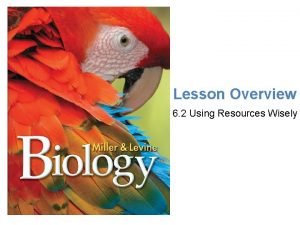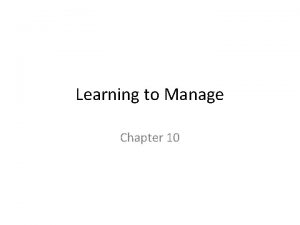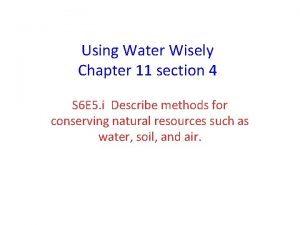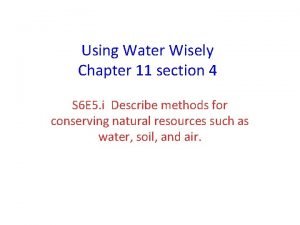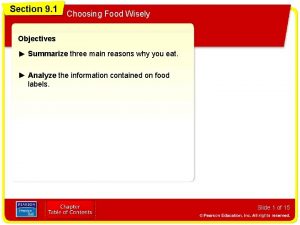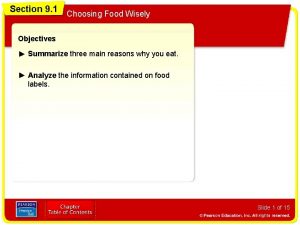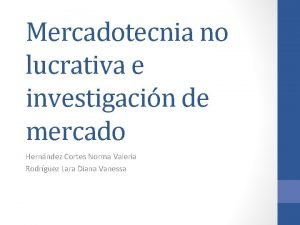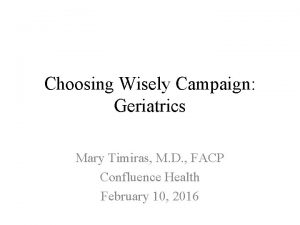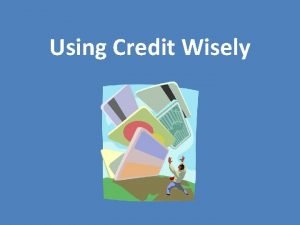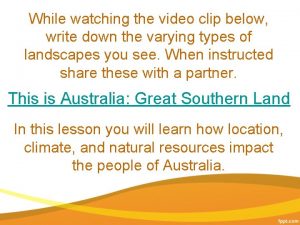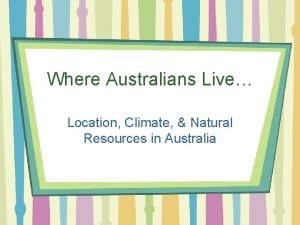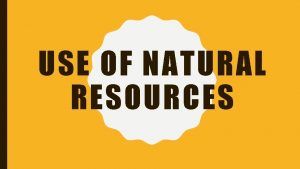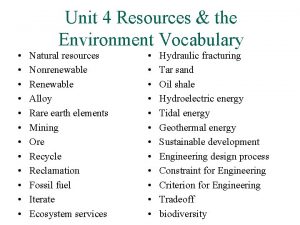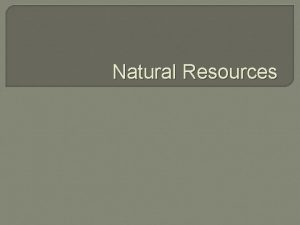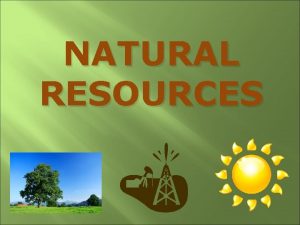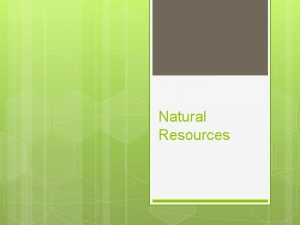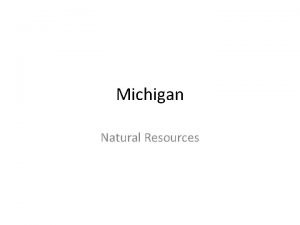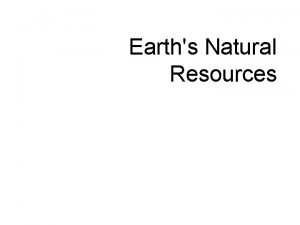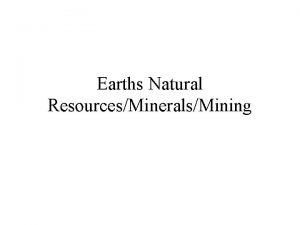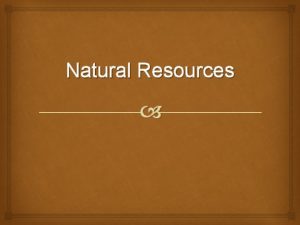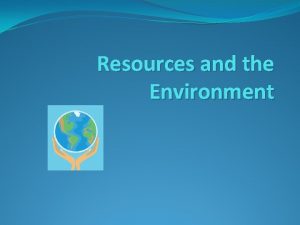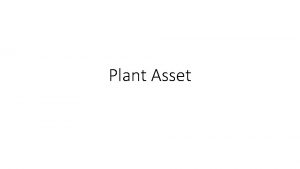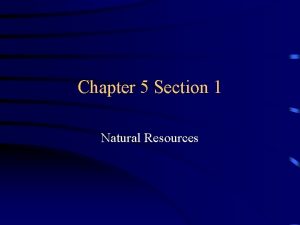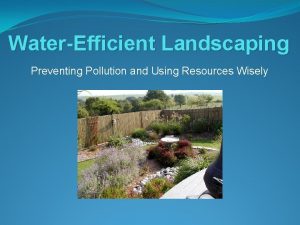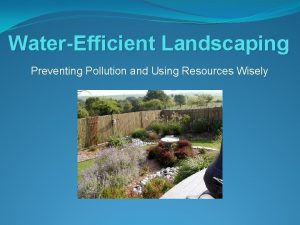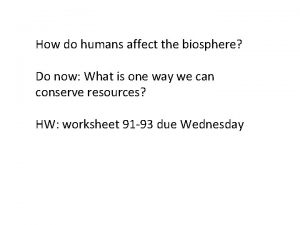Using resources wisely Section 6 2 Natural resources


















- Slides: 18

Using resources wisely Section 6. 2

Natural resources • We need natural resources for our survival • Are we threatening our future existence with our current actions? • 3 types of resources • Soil resources • Freshwater resources • Atmospheric resources

Soil resources • Why is soil so important? • Agriculture and forestry • Topsoil – key for supporting life • Made from healthy interactions between plants and soil • Can take centuries to form, but can be destroyed very quickly

What happened here in the 1930 s?

Soil Erosion • In the dust bowl, the conversion of prairie land to cropland left soil vulnerable to erosion • Soil erosion – loss of soil due to water or wind • Worse when land is plowed and left barren – why? • All the fertile topsoil can be lost • Can lead to desertification • 40% of Earth’s land is at risk

Deforestation • Removing trees can increase soil erosion • When rainforest destroyed for farming – soil is often only good fr a few years, why?

Sustainable soil usage • Soil erosion can me minimized through careful management of agriculture and forestry

Sustainable forestry

Are freshwater resources always renewable? • No! • Only 3% of Earth’s water is freshwater • Most of that is in polar ice caps • Many aquifers have taken millions of years to accumulate

Water pollution • Point source – one specific source • Nonpoint source – released in small amounts by multiple different sources • Primary sources – industrial and agricultural chemicals, sewage and nonpoint sources

Industrial and agricultural chemicals • Heavy metals like mercury, cadmium zinc • DDT – widely used as a herbicide – cheap and effective • Monoculture has lead to reliance on herbicides and pesticides • Run off into ecosystem and have disastrous consequences • New initiatives limit pesticide usage • E. g. biological pest control

Biological magnification • As you move up through a food chain, the concentration of a pollutant will increase • Can reach 10 million times the concentration of the primary producers • DDT was banned in the 1970 s • Mercury is still a problem

Sewage • Highly rich in nitrogen and phosphorous • In small amounts can be handled by an ecosystem • In large amounts destroy entire ecosystems through eutrophication

Watershed conservation • Watershed – all the land whose groundwater, streams and rivers drain into the same place – e. g. a lake • When considering water pollution – the entire watershed and all of it’s ecosystems must be considered • Wetlands and forests are natures water treatment plants

Atmospheric resources • Earth’s atmosphere is naturally maintained through biogeochemical cycles • Human’s are disrupting these cycles, which can have long lasting effects on our atmosphere

Air pollution • Common forms are Smog, acid rain, greenhouse gases and particulates • Smog caused by ozone at ground level • Can cause respiratory illnesses • Acid rain – formed from nitrogen and sulphur released from fossil fuel burning • Can also release dangerous metals such as mercury from soil

Air pollution continued • Greenhouse gas emissions (CO 2 and methane) is leading to global warming • Particulates – microscopic ash and dust particles • Can cause health problems such as asthma

Emissions • Developed countries such as Europe and USA have had many initiatives to improve air quality • For example leaded gasoline were phased out between 1973 - 1996
 Overuse
Overuse Wisely using resources to achieve goals is known as
Wisely using resources to achieve goals is known as Chapter 11 section 4 using water wisely answer key
Chapter 11 section 4 using water wisely answer key We think we are using water wisely because
We think we are using water wisely because 4.3 using studies wisely
4.3 using studies wisely Choosing food wisely quiz
Choosing food wisely quiz Choosing foods wisely quiz
Choosing foods wisely quiz Blank verse othello
Blank verse othello Your words have power use them wisely
Your words have power use them wisely Choosing wisely geriatrics
Choosing wisely geriatrics Janet wisely
Janet wisely As i walk this wicked world
As i walk this wicked world Wisely definition
Wisely definition Natural hazards vs natural disasters
Natural hazards vs natural disasters Natural capital
Natural capital Australia major natural resources
Australia major natural resources Climate of australia
Climate of australia What are the 4 types of natural resources
What are the 4 types of natural resources Natural resources vocabulary
Natural resources vocabulary
